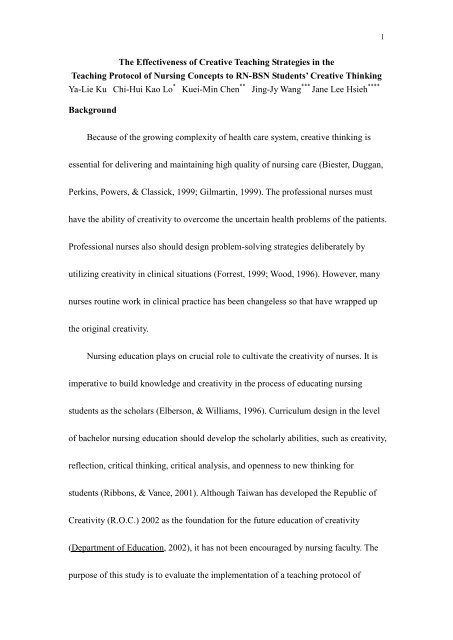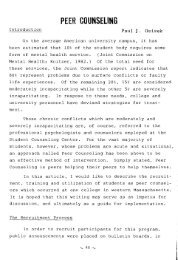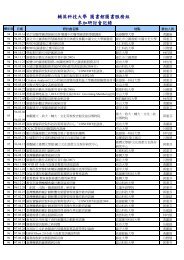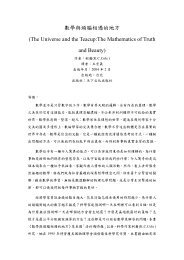The Effectiveness of Creative Teaching Strategies
The Effectiveness of Creative Teaching Strategies
The Effectiveness of Creative Teaching Strategies
Create successful ePaper yourself
Turn your PDF publications into a flip-book with our unique Google optimized e-Paper software.
1<strong>The</strong> <strong>Effectiveness</strong> <strong>of</strong> <strong>Creative</strong> <strong>Teaching</strong> <strong>Strategies</strong> in the<strong>Teaching</strong> Protocol <strong>of</strong> Nursing Concepts to RN-BSN Students’ <strong>Creative</strong> ThinkingYa-Lie Ku Chi-Hui Kao Lo * Kuei-Min Chen ** Jing-Jy Wang *** Jane Lee Hsieh ****BackgroundBecause <strong>of</strong> the growing complexity <strong>of</strong> health care system, creative thinking isessential for delivering and maintaining high quality <strong>of</strong> nursing care (Biester, Duggan,Perkins, Powers, & Classick, 1999; Gilmartin, 1999). <strong>The</strong> pr<strong>of</strong>essional nurses musthave the ability <strong>of</strong> creativity to overcome the uncertain health problems <strong>of</strong> the patients.Pr<strong>of</strong>essional nurses also should design problem-solving strategies deliberately byutilizing creativity in clinical situations (Forrest, 1999; Wood, 1996). However, manynurses routine work in clinical practice has been changeless so that have wrapped upthe original creativity.Nursing education plays on crucial role to cultivate the creativity <strong>of</strong> nurses. It isimperative to build knowledge and creativity in the process <strong>of</strong> educating nursingstudents as the scholars (Elberson, & Williams, 1996). Curriculum design in the level<strong>of</strong> bachelor nursing education should develop the scholarly abilities, such as creativity,reflection, critical thinking, critical analysis, and openness to new thinking forstudents (Ribbons, & Vance, 2001). Although Taiwan has developed the Republic <strong>of</strong>Creativity (R.O.C.) 2002 as the foundation for the future education <strong>of</strong> creativity(Department <strong>of</strong> Education, 2002), it has not been encouraged by nursing faculty. <strong>The</strong>purpose <strong>of</strong> this study is to evaluate the implementation <strong>of</strong> a teaching protocol <strong>of</strong>
2nursing concepts by utilizing creative teaching strategies to promote creativity inRN-BSN students.Literature Review<strong>The</strong> literature in creative thinking is originally started from the field <strong>of</strong> education.Guilford (1950s) proposed the first theory <strong>of</strong> the Structure <strong>of</strong> Intellect (SI model) forthe creativity. Following Guilford, Parnes (1960s), Williams (1970s) andTorrance(1980s), are all devoted into the study <strong>of</strong> creativity. In Taiwan, Chen during1990s developed the ATDE (asking, thinking, doing, evaluation) model for thecreative teaching. Other researchers such as Wu (1980s), Chang (1999), Mao, Kuo,Chen, and Lin (2000) are also involved into the area <strong>of</strong> creative studies. However,only some teaching strategies <strong>of</strong> creativity in nursing literature were introduced. Areview <strong>of</strong> literature on creative thinking is divided into two sections as follows:一 、General EducationGuilford, a psychologist, first developed the theory <strong>of</strong> the Structure <strong>of</strong> Intellect(SI model) during 1950s. Guilford explained that the SI Model is the process <strong>of</strong>integrating with 4 contents (figure, symbol, verbalism, behavior), five operations(cognition, memory, divergent thinking, convergent thinking, evaluation), and sixproducts (unit, category, relation, system, transformation, application). Only divergentthinking and transformation are related to the creativity. Divergent thinking is to think
3broadly from different perspectives that can derive various problem-solving methods.Transformation is to reform the original data into the new definition.Parnes, a behaviorist, during 1960s proposed the factors influencing thecreativity <strong>of</strong> students. Teachers must help students to remove some internal factorsinhibiting their developing creativity such as habit behaviors, dependent behaviors,insecurity, and impulse. Also teachers should reinforce students’ actions <strong>of</strong> creativitysuch as improving students’ knowledge background, imagination, critiquing slowly,and inspire students’ attitudes <strong>of</strong> exploration. Yang and Chen (1993) also addressedthe factors disturbing the developing <strong>of</strong> creativity from students. For instance,students are used to have the standard answers and afraid <strong>of</strong> having differentresponses from teachers. Teachers should prepare a safe, acceptable, and some rules<strong>of</strong> environments to enforce the creativity <strong>of</strong> students.Williams during 1970s designed a creative plan and proposed the creativityconsisting <strong>of</strong> cognitive and affective behaviors. Williams developed 18 teachingstrategies to cultivate the cognitive behaviors <strong>of</strong> students’ creativity such as fluency,flexibility, and originality and affective behaviors such as curiosity, imagination, andtake adventures. During 1980s, Torrance also provided 16 principles <strong>of</strong> creativeteaching to train students to aware the problem and design the solving strategies.Torrance emphasized the needs <strong>of</strong> improvement for the content and method <strong>of</strong>
4teaching to promote the motivation <strong>of</strong> students to be creative.Based on the Guilford’s SI model, Chen during 1990s developed an ATDE(asking, thinking, doing, evaluation) model to cultivate the divergent thinking <strong>of</strong>students. For asking, ten methods <strong>of</strong> asking questions using “If”, “List”, “Besides”,“Compare”, “Similar”, “Replace”, “Imagine”, “Possible”, “Constitute”, “6W” caninspire students to think divergently. For thinking, teachers must allow students tothink at least three seconds for answers. For doing, teachers can choose a guider todirect group discussion consisting <strong>of</strong> 5-10 students through brainstorming. Forevaluation, teachers should encourage students to do self-evaluation by following twoprinciples, “critique slowly” and “accept more”.Regarding the definitions <strong>of</strong> creativity, Guilford has defined creative thinking asfluency, flexibility, originality, sensitivity, and elaboration (Guilford, 1956). In 1970,Williams addressed that creativity should include fluency, flexibility, originality, andelaboration. Demetrulias and Shaw (1985) later work supported inclusion fluency,flexibility, associative thinking, and originality in creativity. <strong>The</strong>n Dowd (1995)proposed that creativity should consist <strong>of</strong> fluency, flexibility, and originality. Finally,Chen (1998) and Chang’s (1999) definition <strong>of</strong> creativity was fluency, flexibility,originality, and elaboration.Overall, fluency, flexibility, and originality are the most frequently recognized as
5the components <strong>of</strong> creativity. Because Torrance’s (1974) Tests <strong>of</strong> <strong>Creative</strong> Thinking(TTCT) are the most popular instrument used to test the creativity in the field <strong>of</strong>education, Wu (1985) has applied the Torrance’s definition <strong>of</strong> creativity into theresearch <strong>of</strong> general education. According to Torrance (1974), fluency is the totalnumber <strong>of</strong> responses students report, flexibility is the number <strong>of</strong> different categories<strong>of</strong> responses students report. Originality is defined as the numbers <strong>of</strong> responses thatoccurred with a frequency <strong>of</strong> 5% or more among the total responses in the data setwere scored 0 for originality; those with a frequency <strong>of</strong> 2% to 4.99% were scored 1,and those with a frequency less than 2% were scored 2.二 、Nursing EducationRecent nursing literature has continuously emphasized the innovation andcreativity because nurses must have creativity, flexibility, independence, criticalthinking, and collaboration to meet the demands in the healthcare (Lewis, Brand,Duckett, & Fairbanks, 1997; Potgieter, 1999). Also, it is imperative to buildknowledge and creativity in the process <strong>of</strong> educating nursing students as the scholars(Elberson, & Williams, 1996). <strong>The</strong> University education is to develop the scholarlyabilities <strong>of</strong> nursing students such as creativity, reflection, critical thinking, criticalanalysis, and openness to new thinking (Ribbons, & Vance, 2001). Creativity in thenursing literature can be divided into two categories: clinical and educational sections.
6In the clinical practice, a study by Berg and Hallberg (1999), twenty-two nursesin a general psychiatric ward were tested before, during, and after one year <strong>of</strong>systematic clinical supervision. Results identified that systematic supervision <strong>of</strong>clinical nursing care can improve the creativity <strong>of</strong> nurses and the organizationalclimate (Berg, & Hallberg, 1999). Titchen and Binnie (1995) suggested threesupervision strategies such as using a clinical story to demonstrate each demand fromthe supervisor and the <strong>of</strong>fers from the nurses that can nurture the creativity <strong>of</strong> nursingstaffs.Except for the systematic supervision, Webster (1998) introduced an innovativeprocess to teach adult nursing staff and spur their creativity, team working, andindividual accountability. <strong>The</strong> use <strong>of</strong> creative teaching strategies in nursing staffdevelopment can inspire enthusiasm for learning (Geyer, & Korte, 1990). Anderson(1998) also suggested that matching the teaching style <strong>of</strong> nursing preceptors with thelearning style <strong>of</strong> new nursing staffs with the orientation creatively can maximize theirjob satisfaction. <strong>The</strong> factors for job satisfaction has been ranked by the directors <strong>of</strong>nursing staff as the intrinsic variables such as creativity, moral values, social service,ability utilization and responsibility (Rehtz, 1995).Besides, Robbins (1997) suggested nurses to use Nursing InterventionsClassification (NIC) into a nursing care plan <strong>of</strong> tertiary acute care facility by utilizing
7the creative teaching strategies. Through NIC with using creative teaching strategies,the clients with multiple sclerosis (MS) can use open communication and creativity todeal with the problems <strong>of</strong> fatigue, impotence, decreased vaginal lubrication,dysfunction <strong>of</strong> bladder and bowel (Weiss, 1992).For clinical teaching, the central essential elements <strong>of</strong> nursing students’expectations <strong>of</strong> faculty guidance activities in the clinical laboratory are criticalthinking, pr<strong>of</strong>essional judgement, application <strong>of</strong> knowledge, and fostering creativity(Heims. 1991). Gross, Aysse, and Tracey (1993) designed a creative education modelfor the first-semester students’ clinical practicum. Students are paired in a one to onerelationship with a staff nurse who will be served as a role model. Responses to thismodel from students’, nursing staffs’ and faculty’s perspectives indicate that thepaired model has worked in improving creativity <strong>of</strong> beginning nursing students in aclinical setting.Anthony (1998) utilized an artistic expression model by teaching Haiku (anancient Japanese poetry) to encourage the nursing beginning students to verbiage theirperceptions in relation to the clients through writing an ancient Japanese unrhymedform <strong>of</strong> poetry. Through the poems, the nursing beginning students can create thedifferent kind <strong>of</strong> writings to identify their major concerns about their clients. Mueller,Johnston and Bligh (2001) also introduced a mind mapping as the alternative nursing
8care plans to stimulate creativity <strong>of</strong> the nursing students.In the educational studies, nursing education literature emphasizes theimportance <strong>of</strong> teaching students to think creatively to meet the challenges <strong>of</strong> 21 stcentury health care delivery (Le Storti et al., 1999). Creativity is the character <strong>of</strong>teaching resulting in empowerment between students and teachers (Chally, 1992). Forinstances, Greiner and Valiga (1998) have proposed that nurse educators can use somecreative teaching strategies such as stories, analogies, parables, and metaphors(Trunnell, Evans, Richards, Grosshans, 1997) to fulfill students’ health promotionresponsibility.Also, a nursing portfolio is a creative way for traditional nursing or RN studentsto document their achievements, past works, and life experiences without taking astandardized test (Alexander, Graft, Baldwin, Beers, & McDaniel, 2002). Besides,individualization as the creative teaching strategy for mater’s prepared nursingstudents to develop the home health care experiences <strong>of</strong> creativity (Alley, Donckers,King, 1992).Additional writings support case method, seminar format, and workshop weregood ways to improve nursing students’ creativity. Wade (1999) utilized the casemethod approach to help nursing students understand the complexity <strong>of</strong> patients’real-life situation to encourage their flexibility, creativity, change, and risk taking in
9providing care. Seminar format teaching increased the skills <strong>of</strong> traditional RNstudents in creativity, autonomy, and flexibility (Rains, Richardson, & Fowler, 1999).A group <strong>of</strong> nursing students have developed creativity workshops for the parents withthe preterm babies under risk at the University <strong>of</strong> Sao Paulo Hospital (Brunherotti,Pereira, de Souza, Nogueira, & Scochi, 2000).Finally, the assignments nursing faculty designed can inspire nursing students’creativity. Slaninka (1999) applied creative teaching strategies in a course <strong>of</strong> nursingtheory and derived the outcomes <strong>of</strong> the students’ presentation and term paperassignments creatively. Also, Olivet and Jones (1997) used the telecommunicationtechnology for innovation and creativity in nursing graduate education. Besides,nursing instructors designed the assignments with technology-assist can encouragestudents to collaborate with one another to promote their abilities <strong>of</strong> solving problemscreatively (Mastrian, & McGonigle, 1999). Additionally, nursing educators have usedtelevision games as effective teaching strategies to help students to developimagination and creativity (Youseffi, Caldwell, Hadnot, Blake, 2000).Definition <strong>of</strong> Terms1. Fluency: <strong>The</strong> total number <strong>of</strong> problem-solving strategies in clinical situationsreported by the students.
102. Flexibility: <strong>The</strong> number <strong>of</strong> different categories <strong>of</strong> problem-solving strategies inclinical situations reported by the students.3. Originality: <strong>The</strong> number <strong>of</strong> novel, elegant, or unusual problem-solving strategiesin clinical situations reported by the students. Responses that occurred with afrequency <strong>of</strong> 5% or more among total responses in the data set were scored 0 fororiginality; those with a frequency <strong>of</strong> 2% to 4.99% were scored 1, and those with afrequency less than 2% were scored 2.DesignThis study design is a time series and two groups experiment utilized multipleinstitutions <strong>of</strong> treatment to measure the creativity <strong>of</strong> 52 two-year and 69 three-yearRN-BSN students at four different points in time. <strong>The</strong> research protocol consists <strong>of</strong>three semester courses including 12 credits lectures and 9 credits practicum. Ateaching model <strong>of</strong> creativity with various strategies included the process <strong>of</strong> asking,thinking, doing, and evaluation are applied into each <strong>of</strong> teaching protocol <strong>of</strong> nursingconcepts to improve both groups <strong>of</strong> RN-BSN students’ fluency, flexibility, andoriginality.Sample<strong>The</strong> purposive sample includes 52 two-year and 69 three-year RN-BSN studentswho had registered nursing licenses and worked for at least one year in a clinical
11setting. It was assumed that one year’s experience after completing a junior collegeprogram would enable them to think conceptually about patient’s problems. Bothgroups <strong>of</strong> RN-BSN students have completed the courses in the teaching protocol <strong>of</strong>Nursing Concepts within three semesters and the teaching strategies <strong>of</strong> creativity areapplied into each <strong>of</strong> teaching units.Instrument一 、Creativity in the application <strong>of</strong> the Nursing Process Tool<strong>The</strong> instrument “Creativity in the application <strong>of</strong> the Nursing Process Tool(CNPT)” integrating the nursing process designed by Emerson (1988) was used in thisstudy. <strong>The</strong> steps in nursing process as defined by Marriner (1983) include assessment,planning, implementation, and evaluation. <strong>The</strong> content validity <strong>of</strong> English-versionCNPT was .83 including eight major questions. <strong>The</strong> question number one, for instance,is “List all the consequences to health care if people have only black and whitevision.” In this study, the CNPT was translated into Chinese. Five experts who haveinvolved in the research <strong>of</strong> creativity assessed the content validity <strong>of</strong> Chinese-versionCNPT. As a result, question number 3 was irrelevant for measuring the fluency,flexibility, and originality and was deleted. Finally, the content validity index <strong>of</strong>Chinese-version CNPT approached at 0.79.二 、Coding GuideChinese-version CNPT includes seven major questions within 20 open-ended
12questions. Narrative answers from the randomly selected 5 questionnaires were readand classified into the different categories by two nursing researchers. Ten nursingeducation experts were invited to assess the relevance <strong>of</strong> each category in the clinicsas well as the accurate and appropriate items under each category. <strong>The</strong> coding guideswere modified following the process <strong>of</strong> coding when two nursing researchers havefound the new categories. Within 20 open-ended questions, 6 to 19 categories weredeveloped as coding guides.Data Collection and AnalysisFifty-two two-year and 69 three-year RN-BSN students <strong>of</strong> a southern Universitywere invited to participate in this study. Due to various scheduling problems, only 30two-year and 44 three-year RN-BSN students have completed the four times tests,giving a 58% and 64% returned rate. Both groups <strong>of</strong> RN-BSN students weremeasured by their fluency, flexibility, and originality before the first semester and theend <strong>of</strong> each semester from March, 1999 to May, 2001.<strong>The</strong> investigator explained the purpose <strong>of</strong> this study to 52 two-year and 69three-year RN-BSN students while collecting data. Also, each student was given asmall gift as an incentive for participating in this study. Two researchers coded thedata by following the coding guides. Inter-coder reliability between the twoinvestigators was .84. Data were then analyzed by utilizing SPSS Paired t statistics to
13compare the fluency, flexibility, and originality from pretest to test III.Result一 、Demographics<strong>The</strong> average age <strong>of</strong> the sample is from 21 to 30 years old; however, thethree-year RN-BSN students were older than the two-year students’ significantly. <strong>The</strong>majority <strong>of</strong> both groups (89% and 78%) were not married and graduated from 5-yearnursing program (65% and 68%). Almost half <strong>of</strong> two-year RN-BSN students wereeither nurses or registered nurses (48% and 48%); however, the majority <strong>of</strong> three-yearRN-BSN students were registered nurses (54%). In working experiences, three-yearRN-BSN students (6-10 years) worked longer than the two-year students’ (1-5 years)significantly. <strong>The</strong> majority <strong>of</strong> both groups (67% and 81%) worked either in themedical unit or surgical unit. <strong>The</strong> demographics <strong>of</strong> two-year and three-year RN-BSNstudents were indicated in the Table 1.二 、Fluency、Flexibility、Originality<strong>The</strong> results indicated that the creativity <strong>of</strong> both groups in the fluency andflexibility tend to be improved after the second semester and the improvement hadbecome significantly in the third semester. <strong>The</strong> fluency and flexibility <strong>of</strong> two-yearRN-BSN students tend to be better than the three-year students’. However, originalityin both groups tends to be declined, but three-year RN-BSN students seem to perform
14better in the originality than the two-year students’. <strong>The</strong> study findings were indicatedin the Table 2.DiscussionAccording to the literature, no research has done about the creativity includingfluency, flexibility, and originality in nursing students. Only some teaching strategieshave been introduced for nursing faculty to help students to develop the creativity.This study has applied the definition <strong>of</strong> fluency, flexibility, and originality from theTorrance’s (1974) and transformed them into the nursing. Also, Chen (1990)’s ATDEmodel was used in this study to cultivate RN-BSN students’ creativity.<strong>The</strong> fluency and flexibility <strong>of</strong> both groups tended to decline after the firstsemester that indicate RN-BSN students may have the difficulties to take the teachingprotocol <strong>of</strong> Nursing Concepts at the initial time. As Anthony’s (1998) Haiku andJohnston and Bligh’s (2001) mind mapping, nursing faculty have requested studentsto write the daily journals to express their opinions about the teaching protocol <strong>of</strong>Nursing Concepts. Through various ideas from the daily journals, nursing faculty canunderstand inhibits from the RN-BSN students to develop the creativity in theteaching protocol <strong>of</strong> Nursing Concepts. As Parnes’ (1960s) suggestions, teachers musthelp students to remove internal factors inhibiting them to develop the creativity.Nursing faculty can prepare the open, free, and safe environment as Yang and Chen’s
15(1993) advices to encourage students to have different opinions from the teachers.Not until the third semester, have the fluency and flexibility <strong>of</strong> both groupsimproved significantly. <strong>The</strong> study <strong>of</strong> Berg and Hallberg (1999) has emphasized thefunction <strong>of</strong> systematic supervision to improve nurses’ creativity. Similarly, this studyhas spent three semesters to supervise RN-BSN students’ creativity systematically.<strong>The</strong> results indicate that the fluency and flexibility <strong>of</strong> both groups have declined afterthe first semester; however, the improvement <strong>of</strong> fluency and flexibility started fromthe second semester and continue to become significantly after the third semester. <strong>The</strong>cultivation <strong>of</strong> RN-BSN students’ creativity does take time.Since the originality <strong>of</strong> both groups has declined, nursing faculty may designteaching strategies more special on the originality. Trunnell, Evans, Richards, andGrosshans (1997) have suggested to use stories, analogies, parables, and metaphors toimprove nursing students’ creativity. Also, nursing portfolio was introduced as thecreative way for RN-BSN students to record the past experiences (Alexander, Graft,Baldwin, Beers, & McDaniel, 2002). Nursing faculty can create the unusual clinicalsituations within the analogical concepts during case analysis and lead studentsbrainstorming by using metaphors. In addition, nursing faculty can suggest students toinquiry experts from the other field for the ideas <strong>of</strong> different nursing interventionsbeing transformed.
16In compared with both groups, the fluency and flexibility <strong>of</strong> 2-year students wasbetter than the 3-year students’. On the other hand, the originality <strong>of</strong> 3-year studentsperformed better than the 2-year students’. Because three-year students were olderand work longer than the 2-year students’, three-year students may think special andunique ideas <strong>of</strong>ten. However, the 2-year students were younger and had less workingexperiences so that they have more chance to inspire the imagination. <strong>The</strong>refore,two-year students may report many ideas.LimitationFive limitations are explored in this study. First, this study was lack <strong>of</strong> twopretests as compared to the posttests within the second and third semesters so thatmaturation existed to affect the internal validity <strong>of</strong> this study. Also, this study did nothave a control group to compare to in terms <strong>of</strong> research results. Besides, a teachingprotocol <strong>of</strong> nursing concepts is used in this study by applying critical, creative,problem-solving, integrate teaching strategies to improve RN-BSN students’ fourabilities <strong>of</strong> critical and creative thinking, problem-solving, and integration. This studydid not have control group and used mixed teaching strategies so that research resultscould not be explained exclusively from the effect <strong>of</strong> creative teaching strategies.In addition, subjects in this study were purposively selected from two-year andthree-year RN-BSN students so that the findings could not be generalized to other
17nursing student populations. Finally, the returned rate in this study is only 58% and64% that a small sample size (N=30 and N=44) might impact the results <strong>of</strong> statisticalanalysis.AcknowledgementsUpon completing this study, I would like to give special thanks to our NationalScience Council to support this study, Kuei-Lan Yang and Shih-Tau Hwang havedeveloped the proposal, Ling-Huang Wang and Huey-Shyan Lin worked on the datacoding and analysis, Yu-Chu Yeh and ten nursing education experts have helped torevise the questionnaire as well as built the coding guides.ReferencesAlexander, J. G., Craft, S. W., Baldwin, M. S., Beers, G. W., & McDaniel, G. S.(2002). <strong>The</strong> nursing portfolio: a reflection <strong>of</strong> a pr<strong>of</strong>essional. Journal <strong>of</strong> ContinuingEducation in Nursing, 33(2), 55-59.Anderson, J. K. (1998). Orientation with style: matching teaching/learning style.Journal for Nurses in Staff Development, 14(4), 192-197.Anthony, M. L. (1998). <strong>Teaching</strong> tools. Nursing students and haiku…simpleunrhymed Japanese verse. Nurse Educator, 23(3), 14-16.Berg, A., & Hallberg, I. R. (1999). Effects <strong>of</strong> systematic clinical supervision onpsychiatric nurses’ sense <strong>of</strong> coherence, creativity, work-related strain, job satisfactionand view <strong>of</strong> the effects from clinical supervision: A pre-post test design. Journal <strong>of</strong>Psychiatric & Mental Health Nursing, 6(5), 371-381.Biester, D. J., Duggan, M., Perkins, M., Powers, L. K., & Classick, S. (1999).Quality care in an era <strong>of</strong> retrenchment. Journal <strong>of</strong> the Society <strong>of</strong> Pediatric Nurses, 4(4),
18141-145.Brunherotti, M. R., Pereira, F. L., de Souza, M. I., Nogueira, F. S., & Scochi, C.G. S. (2000). Recreational activities for parents <strong>of</strong> preterm babies: an experience at theUniversity <strong>of</strong> Sao Paulo Hospital. Revista Brasileira de Enfermagem, 53(3), 435-442.Chally, P. S. (1992). Empowerment through teaching. Journal <strong>of</strong> NursingEducation, 31(3), 117-120.Chang, U. C. (1999). <strong>The</strong> strategies <strong>of</strong> asking questions for teachers. Taipei:Psychology.Chen, L. A. (1990). [Asking, Thinking, Doing, Evaluation] the development andtesting a teaching model <strong>of</strong> creativity. Unpublished doctoral dissertation, NationalTaiwan Normal University, Taipei.Chen, L. A. (1998). <strong>The</strong>ory and practice <strong>of</strong> creative thinking teaching. Taipei:Psychology.Demetrulias, D. M., & Shaw, R. J. (1985). Encouraging divergent thinking.Nurse Educator, 10(6), 12-17.Department <strong>of</strong> Education. (2002). Republic <strong>of</strong> Creativity. Taipei, TW: Jiang TianPublication.Dowd, S. (1995). <strong>Teaching</strong> methods to foster creative thinking. RadiographyToday, 61(697), 19-20.Dunbar, S. B., & Hooper-Kyriakidis, P. (1998). Discover, teacher, friend: Atribute to Marguerite Kinney, Journal <strong>of</strong> Cardiovascular Nursing, 12(2), 56-64.Elberson, K. L., & Williams, S. A. (1996). Innovative strategies for promotingclinical scholarship: a holistic approach. Holistic Nursing Practice, 10(3), 33-40.Emerson, R. J. (1988). Design and validation <strong>of</strong> an instrument for themeasurement <strong>of</strong> creativity in the application <strong>of</strong> the nursing process. Unpublisheddoctoral dissertation, Gonzaga University: Spokane, WA.
19Forrest. S. (1999). Creativity on the edge <strong>of</strong> chaos. Seminars for Nurse Managers,7(3), 136-140.Geyer, K. A., & Korte, P. D. (1990). Creativity in nursing staff development.Journal <strong>of</strong> Nursing Staff Development, 6(3), 112-117.Gilmartin, M. J. (1999). Creativity: <strong>The</strong> fuel <strong>of</strong> innovation. NursingAdministration Quarterly, 23(2), 1-8.Greiner, P. A., & Valiga, T. M. (1998). <strong>Creative</strong> educational strategies for healthpromotion. Holistic Nursing Practice, 12(2), 73-83.Gross, J. W., Aysse, P., & Tracey, P. (1993). A creative clinical education model:Three views. Nursing Outlook, 41(4), 156-159.Guilford, J. P. (1956). <strong>The</strong> structure <strong>of</strong> intellect. Psychological Bulletin, 52,267-293.Heims, M. L. B. (1991). An exploration <strong>of</strong> nursing students’ expectations <strong>of</strong>faculty guidance-related essential elements in the clinical laboratory. Unpublisheddoctoral dissertation, Portland State University, U.S.A.Kao, C. H. (2001-2002). NANDA nursing diagnosis handbook. Taipei, TW:Hua-Xin Publication.Le Storti, A. J., Gullen, P. A., Hanzlik, E. M., Michiels, J. M., Piano, L. A.,Ryan, P. L., & Johnson, W. (1999). <strong>Creative</strong> thinking in nursing education: Preparingfor tomorrow’s challenges. Nursing Outlook, 47(2), 62-66.Lewis, M. L., Brand, K. P., Duckett, L., & Fairbanks, D. (1997). Preparingnurses for tomorrow’s reality: strategies from an honors program. Nurse Educator,22(1), 12-16.Mao, L. W., Kuo, Y. G., Chen, L. A., & Lin, C. T. (2000). Research <strong>of</strong> creativity.Taipei: Psychology.Marriner, A. (1983). Unification <strong>of</strong> nursing education and service. Nursing
20Administration Quarterly, 8(1), 58-64.Mastrian, K. G., & McGonigle, D. (1999). Using technology-based assignmentsto promote critical thinking. Nurse Educator, 24(1), 45-47.Mueller, A., Johnston, M., & Bligh, D. (2001). Mind-mapped care plans: aremarkable alternative to traditional nursing care plans. Nurse Educator, 26(2),75-80.Olivet, L. W., & Jones, T. C. (1997). Electronic education: Collaborativeteaching: a strategy for interactive telecourses. Nurse Educator, 22(1), 6-8.Parnes, S. J. (1967). <strong>Creative</strong> behavior guidebook. New York: Charles Scribner’sSons.Potgieter, E. (1999). <strong>The</strong> whole brain creativity model: implications for nursingeducation and practice. Curationis, 22(4), 41-48.Rains, J. W., Richardson, V., & Fowler, B. A. (1999). Combining traditional andRN students in a senior capstone experience: <strong>The</strong> student perspective. Journal <strong>of</strong>Continuing Education in Nursing, 30(2), 52-55.Rehtz, C. J. (1995). Job satisfaction <strong>of</strong> directors <strong>of</strong> nursing staff development inteaching hospitals. Unpublished doctoral dissertation, <strong>The</strong> University <strong>of</strong> Rochester.Ribbons, R., & Vance, S. (2001). Using e-mail to facilitate nursing scholarship.Computers in Nursing, 19(3), 105-113.Robbins, B. T. (1997). Application <strong>of</strong> nursing intervention classification (NIC)in a cardiovascular critical care unit. Journal <strong>of</strong> Continuing Education in Nursing,28(2), 78-82.Slaninka, S. C. (1999). Nursing theories: creative teaching strategies make thiscourse come alive. Nurse Educator, 24(3), 40-43.Song, H. G., Chen, G. I., & Lee, C. I. (1996). Nursing InterventionClassification (NIC). St. Louis, MO: Mosby-Year Book.
21Titchen, A., & Binnie, A. (1995). <strong>The</strong> art <strong>of</strong> clinical supervision. Journal <strong>of</strong>Clinical Nursing, 4(5), 327-334.Torrance, E. P. (1974). <strong>The</strong> Torrance Tests <strong>of</strong> <strong>Creative</strong> Thinking: Technicalnorms manual. Bensenville, IL: Scholastic Testing Services.Torrance, E. P. (1988). <strong>The</strong> nature <strong>of</strong> creativity as manifest in the testing. In R. J.Sternberg (Ed.), <strong>The</strong> nature <strong>of</strong> creativity. Cambridge: Cambridge University Press.Trunnell, E. P., Evans, C., Richards, B., & Grosshans, O. (1997). Factorsassociated with creativity in health educators who have won university teachingawards: a modified qualitative approach. Journal <strong>of</strong> Health Education, 28(1), 35-41.Wade, G. H. (1999). Using the case method to develop critical thinking skillsfor the care <strong>of</strong> high-risk families. Journal <strong>of</strong> Family Nursing, 5(1), 92-109.Webster, M. R. (1998). Documentation in the land <strong>of</strong> perfect charts: how to turnyour frogs into princes. Journal for Nurses in Staff Development, 14(6), 283-285.Weiss, J. (1992). Multiple sclerosis: will it come between us? Sexual concerns<strong>of</strong> clients and their partners. Journal <strong>of</strong> Neuroscience Nursing, 24(4), 190-193.Williams, F. (1970). Classroom ideas for encouraging thinking and feeling.New York, NY: D.O.K.Wood, M. (1996). President’s view. <strong>Creative</strong> thinking is a “thriving” skill.Registered Nurse Journal, 8(3), 12.Wu, J. J. (1985). <strong>The</strong> creativity <strong>of</strong> young, Central Journal, 10(10), 41-45.Yang, L. L., & Chen, S. L. (1993). Applying creative thinking in nursingteaching. Journal <strong>of</strong> Chang Gung Nursing, 4(2), 6-11.Youseffi, F., Caldwell, R., Hadnot, P., & Blake, B. J. (2000). Recall Rummy:learning can be fun…a card game to reinforce proper skill techniques. Journal <strong>of</strong>Continuing Education in Nursing, 31(4), 161-162.












